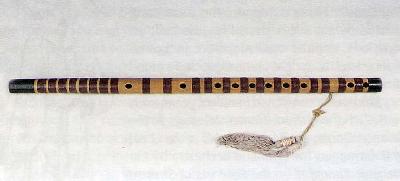| Art Q&A > Music |
|
|
History of Dizi (Bamboo Flute)
Dizi, a traditional Chinese musical instrument, became popular as early as the Warring States Period (475-221BC). It first appeared in Hemudu Clan (in present-day Hubei Province) 7,000 years ago.
There are two basic kinds of Dizi -- Bangdi, which was the shorter one, got its name because it was used to accompany clapper-type operas. It has a strong and piping tone, suitable for expressing robust and lively emotions; Qudi, also named as Sudi for its origin from Suzhou city, is often used to accompany Kunqu Opera. It is five levels lower than Bangdi in pitch. Its tone is pure and mellow, making it suitable for expressing delicate and understated moods.
A large number of techniques are used when playing these wind instruments, such as tapping, appoggiatura, tremolo, legato, flower tongue, augment, glide, trill, overtone and prong. Famous Dizi tunes include The Golden Trembling Willows, Audience With the Emperor, Joyous Meeting, Five Clappers, The Partridge Soars, The Bird in the Shade, and Scenic Suzhou. |
||||
All rights reserved. Reproduction of text for non-commercial purposes is permitted provided that both the source and author are acknowledged and a notifying email is sent to us. |
||||
 |
